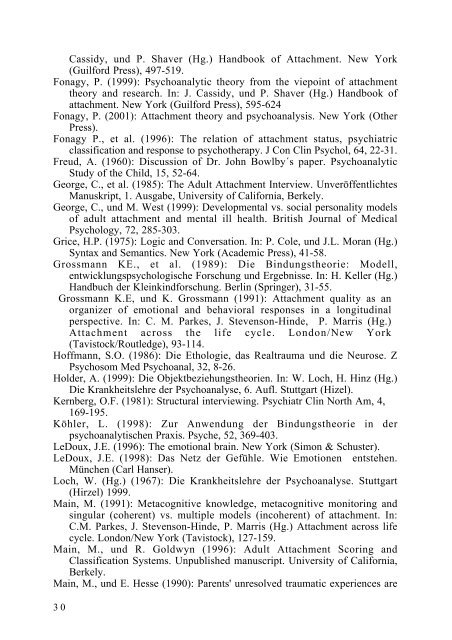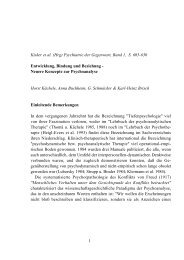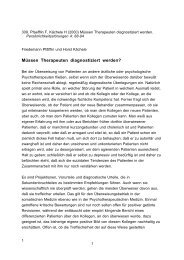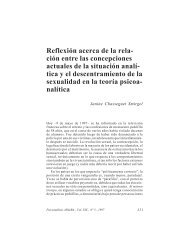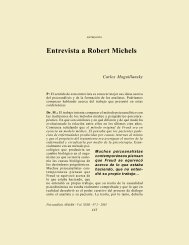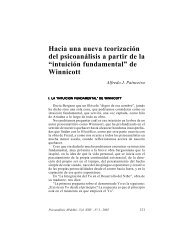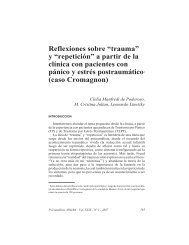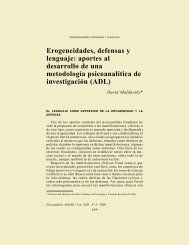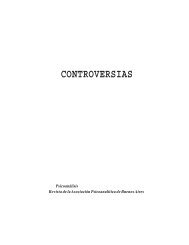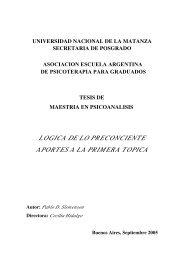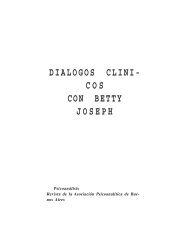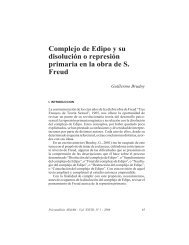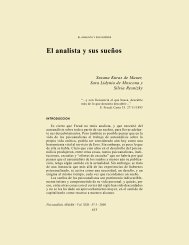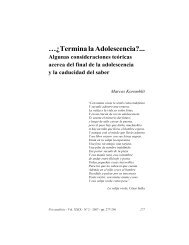Das Adult Attachment Interview und psychoanalytisches Verstehen
Das Adult Attachment Interview und psychoanalytisches Verstehen
Das Adult Attachment Interview und psychoanalytisches Verstehen
Sie wollen auch ein ePaper? Erhöhen Sie die Reichweite Ihrer Titel.
YUMPU macht aus Druck-PDFs automatisch weboptimierte ePaper, die Google liebt.
Cassidy, <strong>und</strong> P. Shaver (Hg.) Handbook of <strong>Attachment</strong>. New York(Guilford Press), 497-519.Fonagy, P. (1999): Psychoanalytic theory from the viepoint of attachmenttheory and research. In: J. Cassidy, <strong>und</strong> P. Shaver (Hg.) Handbook ofattachment. New York (Guilford Press), 595-624Fonagy, P. (2001): <strong>Attachment</strong> theory and psychoanalysis. New York (OtherPress).Fonagy P., et al. (1996): The relation of attachment status, psychiatricclassification and response to psychotherapy. J Con Clin Psychol, 64, 22-31.Freud, A. (1960): Discussion of Dr. John Bowlby´s paper. PsychoanalyticStudy of the Child, 15, 52-64.George, C., et al. (1985): The <strong>Adult</strong> <strong>Attachment</strong> <strong>Interview</strong>. UnveröffentlichtesManuskript, 1. Ausgabe, University of California, Berkely.George, C., <strong>und</strong> M. West (1999): Developmental vs. social personality modelsof adult attachment and mental ill health. British Journal of MedicalPsychology, 72, 285-303.Grice, H.P. (1975): Logic and Conversation. In: P. Cole, <strong>und</strong> J.L. Moran (Hg.)Syntax and Semantics. New York (Academic Press), 41-58.Grossmann KE., et al. (1989): Die Bindungstheorie: Modell,entwicklungspsychologische Forschung <strong>und</strong> Ergebnisse. In: H. Keller (Hg.)Handbuch der Kleinkindforschung. Berlin (Springer), 31-55.Grossmann K.E, <strong>und</strong> K. Grossmann (1991): <strong>Attachment</strong> quality as anorganizer of emotional and behavioral responses in a longitudinalperspective. In: C. M. Parkes, J. Stevenson-Hinde, P. Marris (Hg.)<strong>Attachment</strong> across the life cycle. London/New York(Tavistock/Routledge), 93-114.Hoffmann, S.O. (1986): Die Ethologie, das Realtrauma <strong>und</strong> die Neurose. ZPsychosom Med Psychoanal, 32, 8-26.Holder, A. (1999): Die Objektbeziehungstheorien. In: W. Loch, H. Hinz (Hg.)Die Krankheitslehre der Psychoanalyse, 6. Aufl. Stuttgart (Hizel).Kernberg, O.F. (1981): Structural interviewing. Psychiatr Clin North Am, 4,169-195.Köhler, L. (1998): Zur Anwendung der Bindungstheorie in derpsychoanalytischen Praxis. Psyche, 52, 369-403.LeDoux, J.E. (1996): The emotional brain. New York (Simon & Schuster).LeDoux, J.E. (1998): <strong>Das</strong> Netz der Gefühle. Wie Emotionen entstehen.München (Carl Hanser).Loch, W. (Hg.) (1967): Die Krankheitslehre der Psychoanalyse. Stuttgart(Hirzel) 1999.Main, M. (1991): Metacognitive knowledge, metacognitive monitoring andsingular (coherent) vs. multiple models (incoherent) of attachment. In:C.M. Parkes, J. Stevenson-Hinde, P. Marris (Hg.) <strong>Attachment</strong> across lifecycle. London/New York (Tavistock), 127-159.Main, M., <strong>und</strong> R. Goldwyn (1996): <strong>Adult</strong> <strong>Attachment</strong> Scoring andClassification Systems. Unpublished manuscript. University of California,Berkely.Main, M., <strong>und</strong> E. Hesse (1990): Parents' unresolved traumatic experiences are30


